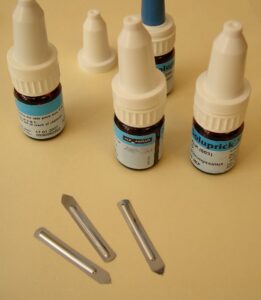- 0044 (0) 207 351 8754
- [email protected]
- Royal Brompton Hospital - London
A blood test can be carried out to get an idea of how allergic a child is in general, called a serum total IgE. Blood tests can also reveal if a child is allergic to a specific thing, for example grass pollen or cats. I feel one has to justify taking blood from a child however, and would only do this if it will change management of that child.
Allergy testing can also be carried out using skin prick tests (SPTs). This is easier for young children than a blood test but can still be alarming for some of them. The validity of this testing in children under 3 years is not so good so I only do this in older children. We usually test for house dust mite, grass & tree pollen, cats and dogs, and aspergillus mould. We can add in other allergens if there is a particular reason e.g. the family has a pet rabbit. A positive result may increase the possibility of making a diagnosis of asthma, although is not diagnostic for it. Its other main use is if there is a pet at home, and we want to know if allergy to the pet is contributing to asthma symptoms.
How is it carried out?


Skin prick testing – on the left are the lancets and bottles of allergens used. On the right you can see a child’s arm at the end of the skin prick test, with strongly positive results for the allergens placed at 3 & 6, mildly positive at 4 & 5, and negative at 7. The positive control is at 1 and the negative control at 2.
A blood test can be carried out to get an idea of how allergic a child is in general, called a serum total IgE. Blood tests can also reveal if a child is allergic to a specific thing, for example grass pollen or cats. I feel one has to justify taking blood from a child however, and would only do this if it will change management of that child.
Allergy testing can also be carried out using skin prick tests (SPTs). This is easier for young children than a blood test but can still be alarming for some of them. The validity of this testing in children under 3 years is not so good so I only do this in older children. We usually test for house dust mite, grass & tree pollen, cats and dogs, and aspergillus mould. We can add in other allergens if there is a particular reason e.g. the family has a pet rabbit. A positive result may increase the possibility of making a diagnosis of asthma, although is not diagnostic for it. Its other main use is if there is a pet at home, and we want to know if allergy to the pet is contributing to asthma symptoms.
How is it carried out?


Skin prick testing – on the left are the lancets and bottles of allergens used. On the right you can see a child’s arm at the end of the skin prick test, with strongly positive results for the allergens placed at 3 & 6, mildly positive at 4 & 5, and negative at 7. The positive control is at 1 and the negative control at 2.
© Dr. Ian Balfour-Lynn
Powered by LondonWeb
Designed by CrestanaDS